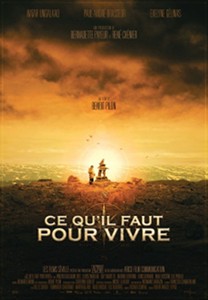|
The Necessities of Life
The Necessities of Life (French: Ce qu'il faut pour vivre) is a 2008 Canadian drama film directed by Benoît Pilon and starring Natar Ungalaaq, Éveline Gélinas and Paul-André Brasseur. Told in both French and Inuktitut, the film is about an Inuit man who is sent to Quebec for tuberculosis treatment. The film was shot in Iqaluit, Nunavut and Quebec City. It received positive reviews and won four Genie Awards, including Best Direction for Pilon, and the Special Grand Prize of the Jury of the Montreal World Film Festival. PlotIn 1952, a tuberculosis epidemic is sweeping Northern Canada, and numerous Inuit are compelled by the government to seek treatment in the lower provinces. One Inuit man from Baffin Island, Tiivii, arrives at a sanatorium in Quebec City. He is treated by a French Canadian nurse, Carole. An orphaned boy, Kaki, also spends time with Tiivii in the institution. Tiivii struggles with the language barrier, being unable to speak French. Kaki speaks both French and Inuktitut, and can translate conversations between Tiivii and Carole. However, the relationship becomes awkward when Tiivii, through Kaki, asks Carole for sex. Kaki had advised him it was a bad idea, citing his greater understanding of white people, though Tiivii felt he had a better understanding of women. Tiivii hopes to adopt Kaki. Cast
ProductionWhen director Benoît Pilon read Bernard Émond's screenplay, he wanted Inuit actor Natar Ungalaaq as the lead role after seeing him in the 2001 Inuit film Atanarjuat: The Fast Runner.[1] Ungalaaq read the screenplay, and found the story personal as his real-life grandfather was diagnosed with tuberculosis during the historical epidemic in the 1950s. He did not disclose this story to the media until after the film was complete.[2] For his role as Kaki, Paul-André Brasseur, who lived in Montreal and spoke French, learned his Inuktitut lines with Ungalaaq's aid.[3] The budget was $4 million.[4] Filming took place over nearly a year, in numerous locations.[1] Arctic scenes were shot around Iqaluit, Nunavut, and other scenes were shot in Quebec City, Quebec.[3] ReleaseThe film was first screened at the Montreal World Film Festival and at the Théâtre Maisonneuve on 25 August 2008. It opened in wider Quebec theatres on 29 August,[5] and was re-released in Montreal, Quebec City and Sherbrooke on 3 April 2009.[6] After the film was submitted for consideration for the Academy Award for Best Foreign Language Film, Entertainment One granted distribution rights for the United States to IFC Films in January 2009.[7] Entertainment One re-released the film in Toronto, Ontario and Vancouver, British Columbia in April 2009.[8] ReceptionCritical responseThe film received critical acclaim.[8] The Necessities of Life has an approval rating of 60% on review aggregator website Rotten Tomatoes, based on 5 reviews, and an average rating of 6.2/10.[9] In Canada, Marc-André Lussier of La Presse called the film beautiful and Natar Ungalaaq strong and charismatic.[10] The Montreal Gazette's Brendan Kelly called it "quite simply one of the best Quebecois films of the year."[5] Normand Provencher of La Presse described it as intelligent and beautiful.[11] In Maclean's, Brian D. Johnson assessed the film as "an immaculately crafted, deeply distressing drama," albeit difficult to watch given the subject matter. Johnson said Ungalaaq displayed grace, but at times was depicted as a noble savage.[12] Linda Barnard, writing for The Toronto Star, called it "A gentle yet moving story," and praised Ungalaaq.[13] Following Quebec's Jutra Awards, MP Marcel Proulx told the House of Commons of Canada in March 2009 that the film was a powerful statement on the distinct cultures of Nunavik and the rest of Quebec. MP Roger Pomerleau also publicly congratulated Ungalaaq.[14] Writing for Variety, Dennis Harvey said "Necessities knows just how to eke maximum poignancy from its events without seeming to manipulate for tearjerking effect."[15] Dan Kois, writing for The Washington Post, called the film "thoughtful and, especially at its end, quite touching," but found it unoriginal and blandly directed.[16] In The Chicago Reader, Cliff Doerksen said parts of the film appear to be no better than a TV movie, "but the acting is understated and strong."[17] AccoladesCanada submitted the film for consideration for the Academy Award for Best Foreign Language Film, one of the rare Canadian selections to feature a substantial amount of Inuktitut, following Atanarjuat: The Fast Runner.[18] In January 2009, Academy members shortlisted the film among nine for the 81st Academy Awards,[19] but it was not nominated.[20] It received the most nominations at the 29th Genie Awards, with eight.[21] See also
References
External links |
||||||||||||||||||||||||||||||||||
